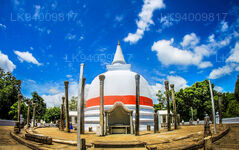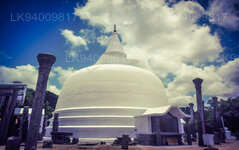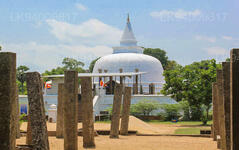
Město Anuradhapura
Anuradhapura patří do severocentrální provincie Srí Lanky. Anuradhapura je jedno ze starobylých hlavních měst Srí Lanky, známé svými dobře zachovalými ruinami starověké lanské civilizace. Město, nyní zapsané na seznamu světového dědictví UNESCO, leží 205 km severně od současného hlavního města Kolomba na Srí Lance.
Lankaramaya (ලංකාරාමය)
Lankaramaya in Sri Lanka: A Temple with Over Two Millenia of History
The tale of the temple Lankaramaya in Sri Lanka is the stuff of legend. The year 103 BC was a memorable year for the King Walagamba (also known as Vattagamini Abaya) of Anuraddhapura. As the rightful king he had been attacked by invaders of the kingdom, and during that year he hid out at a place called Silasobha Khandaka and planned their defeat. His plans worked out well and the invaders were destroyed in the same year, enabling him to be enthroned following the failed invasion.
Silasobha Khandaka held a very special place in his memories, as the place that saved his life and from where he started on the road to his reign. Therefore, he built a stupa in its memory and named it Silasobha Khandaka Cetiya. The stupa was similar in architecture to the Thuparama, the first stupa to be built after the establishment of Buddhism in Sri Lanka in 250 BC. It was built with 88 pillars supporting the roof of the vatadage which appears to have been 45 feet in diameter. The vatadage was a roofed hall like structure that surrounded the actual stupa in the centre, with the entire structure built at 10 feet above ground level.
Lankaramaya in Sri Lanka: Present day status of the Temple
Today the actual stupa has been renovated, but little remains of the vatadage except the ruins of a few broken pillars in the middle of the large courtyard. The name of the stupa too has been changed from Silasobha Khandaka Cetiya to the simpler Lankaramaya.
Lankaramaya, along with the Elephant pond and the old underground canal network (dating back hundreds of years) are excellent examples of the complex architecture used millenia ago. They are interesting sites for archeology and histoty lovers. Lankaramaya is definitely a great place to visit on your holiday to Sri Lanka’s Ancient Kingdom Anuraddhapura.
O okrese Anuradhapura
Anuradhapura patří do severocentrální provincie na Srí Lance. Anuradhapura je jedno ze starobylých hlavních měst Srí Lanky, známé svými dobře zachovalými ruinami starověké lanské civilizace. Město, nyní zapsané na seznamu světového dědictví UNESCO, leží 205 km severně od současného hlavního města Kolomba na Srí Lance. V posvátném městě Anuradhapura a jeho okolí se nachází velké množství ruin. Ruiny se skládají ze tří tříd budov: dagoby, klášterní budovy a pokuny (rybníky). Město mělo jedny z nejsložitějších zavlažovacích systémů starověkého světa a nacházelo se v suché zóně země. Správa vybudovala mnoho nádrží k zavlažování půdy. Většina obyvatelstva jsou Sinhálci, zatímco v okrese žijí Tamilové a srílanští Maurové.
O severocentrální provincii
Severocentrální provincie, která je největší provincií v zemi, pokrývá 16 % celkové rozlohy země. Severocentrální provincie se skládá ze dvou okresů zvaných Polonnaruwa a Anuradhapure. Anuradhapura je největší okres na Srí Lance. Jeho rozloha je 7 128 km². Severocentrální provincie má pro investory mnoho potenciálu k zahájení podnikání, zejména v zemědělství, zemědělském průmyslu a chovu hospodářských zvířat. Více než 65 % obyvatel Severocentrální provincie je závislých na základním zemědělství a zemědělském průmyslu. NCP se také nazývá „Wew Bendi Rajje“, protože se v provincii nachází více než 3 000 středních a velkých nádrží. Sri maha bodiya, Ruwanweli seya, Thuparama dageba, klášter Abayagiri, Polonnaruwa Rankot wehera a Lankathilake se bojí...

















